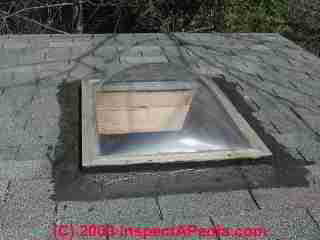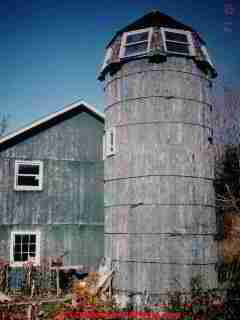 Energy Efficiency of Skylights
Energy Efficiency of Skylights
- POST a QUESTION or COMMENT about the energy efficiency of roof skylights
Skylight energy efficiency guide:
This article explains the energy efficiency of skylights and skylight energy efficiency ratings and factors such as solar gain and the use of low-E skylight glazing. We also discuss the effect of skylight orientation - which roof slope etc., and skylight condensation problems.
InspectAPedia tolerates no conflicts of interest. We have no relationship with advertisers, products, or services discussed at this website.
- Daniel Friedman, Publisher/Editor/Author - See WHO ARE WE?
Skylight Energy Efficiency Guide
 This article group discusses the selection and installation of skylights, including choosing a skylight, how to install the skylight, constructing the skylight well or chute, skylight controls, and skylight shades or screens.
This article group discusses the selection and installation of skylights, including choosing a skylight, how to install the skylight, constructing the skylight well or chute, skylight controls, and skylight shades or screens.
We also discuss skylight condensation and special skylight products such as light tubes.
In this article series we discuss the selection and installation of windows and doors, following best construction and design practices for building lighting and ventilation, with attention to the impact on building heating and cooling costs, indoor air quality, and comfort of occupants.
We review the proper installation details for windows and doors, and we compare the durability of different window and door materials and types. Our photo (page top) shows a skylight with a history of leaks and blob-on patching with roof cement, caulk, and chewing gum.
Article Contents
This article includes excerpts or adaptations from Best Practices Guide to Residential Construction (Steve Bliss, J Wiley & Sons) , by Steven Bliss, courtesy of Wiley & Sons.
See WINDOWS & DOORS our home page for window and door information, and
also see WINDOW TYPES - PHOTO GUIDE for a photographic guide to window and door types and architectural styles.
Our links listed at the ARTICLE INDEX the bottom of this article provide in-depth articles on window and door selection, inspection, installation, problem diagnosis, and repair.
Over glazing with skylights [putting in too many skylights] can increase heat loss in cold, cloudy climates, but the biggest impact of excessive roof glass in most climates is overheating, increasing both peak and annual cooling loads and making people uncomfortably hot.
Solar Heat Gain at Skylights
Because the sun is high in summer and low in winter, skylights tend to capture solar gains at just the wrong time. For example, an unvented skylight set at a 30- to 40-degree slope captures four times as much solar-heat gain in midsummer as a similarly sized vertical window.
To put this in perspective, at noontime on June 21, two single-glazed, 6-square-foot skylights facing south produce nearly as much heat as a 1,000-watt electric space heater. West-facing skylights produce almost as much heat in summer.
Low-E Glazing Solutions for Skylights
Fortunately, the new spectrally selective coatings cut solar gains by nearly 50% compared with clear double glazing, greatly reducing the cooling penalty of skylights.
Still, there is no sense in using more skylights than is needed to produce comfortable light levels, typically 5 to 7% of the floor area being lit.
Where overheating is a possibility, use a venting skylight to change the glass angle and exhaust any heat buildup.
See details at SPECTRALLY SELECTIVE LOW-E WINDOWS
Also see SUNGAIN, FILMS, LOW-E GLASS.
Skylight Orientation
While high-tech glass can significantly reduce solar gains, it is still possible to over glaze and overheat a room. For that reason, south- and west-facing skylights should be kept to a minimum.
Also, south-facing skylights produce a lot of glare from direct summer sun. North-facing skylights consistently provide even, diffused lighting with little heat gain. East-facing skylights generate moderate heat gain on summer mornings, which could pose a problem in hot climates if overused.
Skylight U-Values
The same double-glazing has a higher U-value (lower R-value) when used in a skylight than in a vertical window. Increased convection between the two panes of glass in a horizontal or low-slope orientation causes the greater heat loss in skylights.
Starting in mid 2004, all skylight manufacturers using NFRC labels started reporting U-values measured at a slope of 20 degrees. For older skylights rated at a 90-degree angle, multiply the U-value by 1.2 to get the 20-degree equivalent. This results in a 20% higher U-value.
Avoid Condensation Problems on Skylight Windows
Because warm moist air is carried upward by convection currents, skylights are often one of the first places to develop condensation. This can lead to dripping and staining of the frame, well, or furnishings below.
The best defense against skylight condensation is to choose high R-value glazing with warm-edge spacers. Good insulation of the skylight well also helps by keeping the surrounding area warmer. Several manufacturers offer skylights with integral condensation gutters, a helpful feature in cold climates.
Condensation Resistance of Windows: Measurements
The NFRC (National Fenestration Council) in discussing solar heat gain at windows, describes the Condensation Resistance of Windows (CR) as follows:
Condensation Resistance (CR) measures how well a product resists the formation of condensation. CR is expressed as a number between 1 and 100. The higher the number, the better a product is able to resist condensation. CR is an optional rating, and manufacturers can choose not to include it on their NFRC labels.
Also see CONDENSATION or SWEATING PIPES, TANKS
and DEW POINT TABLE - CONDENSATION POINT GUIDE
as well as HUMIDITY LEVEL TARGET and
see SKYLIGHT LEAK DIAGNOSIS & REPAIR
Skylight Manufacturers & Product Sources
Andersen Windows and Doors www.andersenwindows.com Skylights and roof windows with exterior sash clad with glass-fiber-reinforced material
Milgard Windows and Doors www.milgard.com Skylights with aluminum frames (thermal break optional) with vinyl subframes on operable models; optional motorized controls with rain sensor
Pella Windows and Doors www.pella.com Wood interior, aluminum exterior, optional motorized controls, and manual or motorized fabric-pleated shades
Roto Frank of America www.roofwindows.com Wood interior, aluminum exterior, optional motorized controls, and manual or motorized fabric-pleated shades; Sweet16 model fits 16 in. o.c. framing
Velux America Inc. www.velux.com Skylights and roof windows with wood interior and aluminum-clad exterior. Options include insect screens, blinds, motorized controls and shades with rain sensor, electrochromatic glass, and flashing kits for metal and tile roofs and mulled units
Skylight Light Tube Manufacturers & Sources
SolaTube www.solatube.com Light tubes from 10 to 21 in. in diameter; options include electrical lighting, daylight dimmer, and integral bath fan
Sun-Tek Skylights www.sun-tek.com Light tubes from 10 to 21 in. in diameter; options include electrical lighting and multitube Spyder skylight
Velux America Inc. www.velux.com Sun Tunnel light tubes from 14 to 22 in. in diameter with flexible or rigid tubes
-- Adapted and paraphrased, edited, and supplemented, with permission from Best Practices Guide to Residential Construction (Steve Bliss, J Wiley & Sons) .
...
Continue reading at SKYLIGHT INSTALLATION PROCEDURE or select a topic from the closely-related articles below, or see the complete ARTICLE INDEX.
Or see
WINDOWS & DOORS - home
Or see these
Skylight Articles
Suggested citation for this web page
SKYLIGHT ENERGY EFFICIENCY at InspectApedia.com - online encyclopedia of building & environmental inspection, testing, diagnosis, repair, & problem prevention advice.
Or see this
INDEX to RELATED ARTICLES: ARTICLE INDEX to DOORS & WINDOWS
Or use the SEARCH BOX found below to Ask a Question or Search InspectApedia
Ask a Question or Search InspectApedia
Try the search box just below, or if you prefer, post a question or comment in the Comments box below and we will respond promptly.
Search the InspectApedia website
Note: appearance of your Comment below may be delayed: if your comment contains an image, photograph, web link, or text that looks to the software as if it might be a web link, your posting will appear after it has been approved by a moderator. Apologies for the delay.
Only one image can be added per comment but you can post as many comments, and therefore images, as you like.
You will not receive a notification when a response to your question has been posted.
Please bookmark this page to make it easy for you to check back for our response.
IF above you see "Comment Form is loading comments..." then COMMENT BOX - countable.ca / bawkbox.com IS NOT WORKING.
In any case you are welcome to send an email directly to us at InspectApedia.com at editor@inspectApedia.com
We'll reply to you directly. Please help us help you by noting, in your email, the URL of the InspectApedia page where you wanted to comment.
Citations & References
In addition to any citations in the article above, a full list is available on request.
- Basic Housing Inspection, US DHEW, S 352.75 U48, p.144, out of print, but is available in most state libraries; New York State version, ca 1955, source of our window parts and window repair sketches.
- Best Practices Guide to Residential Construction, by Steven Bliss. John Wiley & Sons, 2006. ISBN-10: 0471648361, ISBN-13: 978-0471648369, Hardcover: 320 pages, available from Amazon.com and also Wiley.com. See our book review of this publication.
- "Solar Heat Gain & Windows, the facts about", NFRC, National Fenestration Rating Council, January 2005, NFRC website: www.nfrc.org retrieved 12/4/2010, original source: http://www.nfrc.org/documents/SolarHeatGain.pdf.
- Our recommended books about building & mechanical systems design, inspection, problem diagnosis, and repair, and about indoor environment and IAQ testing, diagnosis, and cleanup are at the InspectAPedia Bookstore. Also see our Book Reviews - InspectAPedia.
- Decks and Porches, the JLC Guide to, Best Practices for Outdoor Spaces, Steve Bliss (Editor), The Journal of Light Construction, Williston VT, 2010 ISBN 10: 1-928580-42-4, ISBN 13: 978-1-928580-42-3, available from Amazon.com
- The Journal of Light Construction has generously given reprint permission to InspectAPedia.com for adaptations, quotations, or reproductions used at this website. All rights and contents of the JLC material are ©Journal of Light Construction and may not be reproduced in any form.
- In addition to citations & references found in this article, see the research citations given at the end of the related articles found at our suggested
CONTINUE READING or RECOMMENDED ARTICLES.
- Carson, Dunlop & Associates Ltd., 120 Carlton Street Suite 407, Toronto ON M5A 4K2. Tel: (416) 964-9415 1-800-268-7070 Email: info@carsondunlop.com. Alan Carson is a past president of ASHI, the American Society of Home Inspectors.
Thanks to Alan Carson and Bob Dunlop, for permission for InspectAPedia to use text excerpts from The HOME REFERENCE BOOK - the Encyclopedia of Homes and to use illustrations from The ILLUSTRATED HOME .
Carson Dunlop Associates provides extensive home inspection education and report writing material. In gratitude we provide links to tsome Carson Dunlop Associates products and services.

